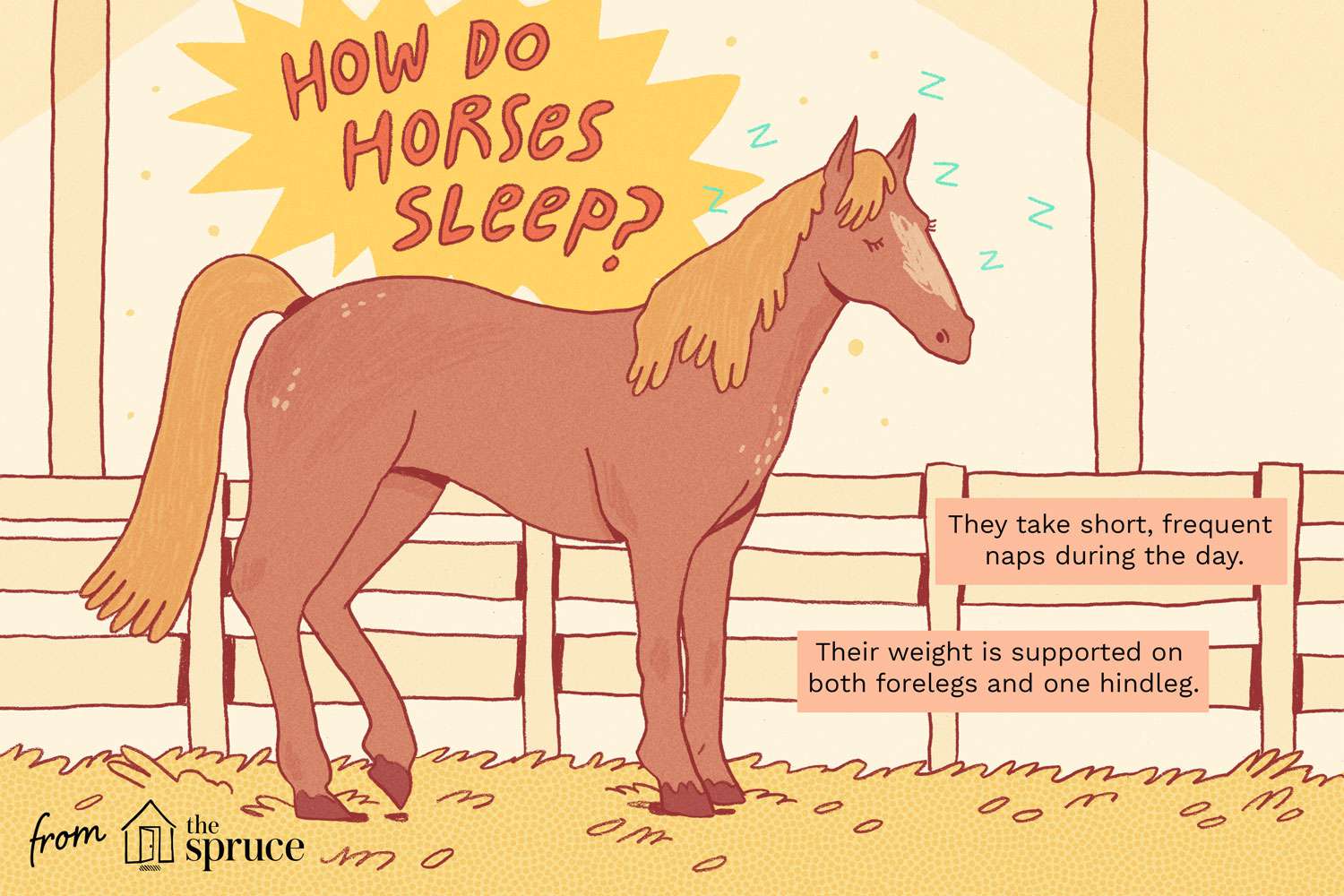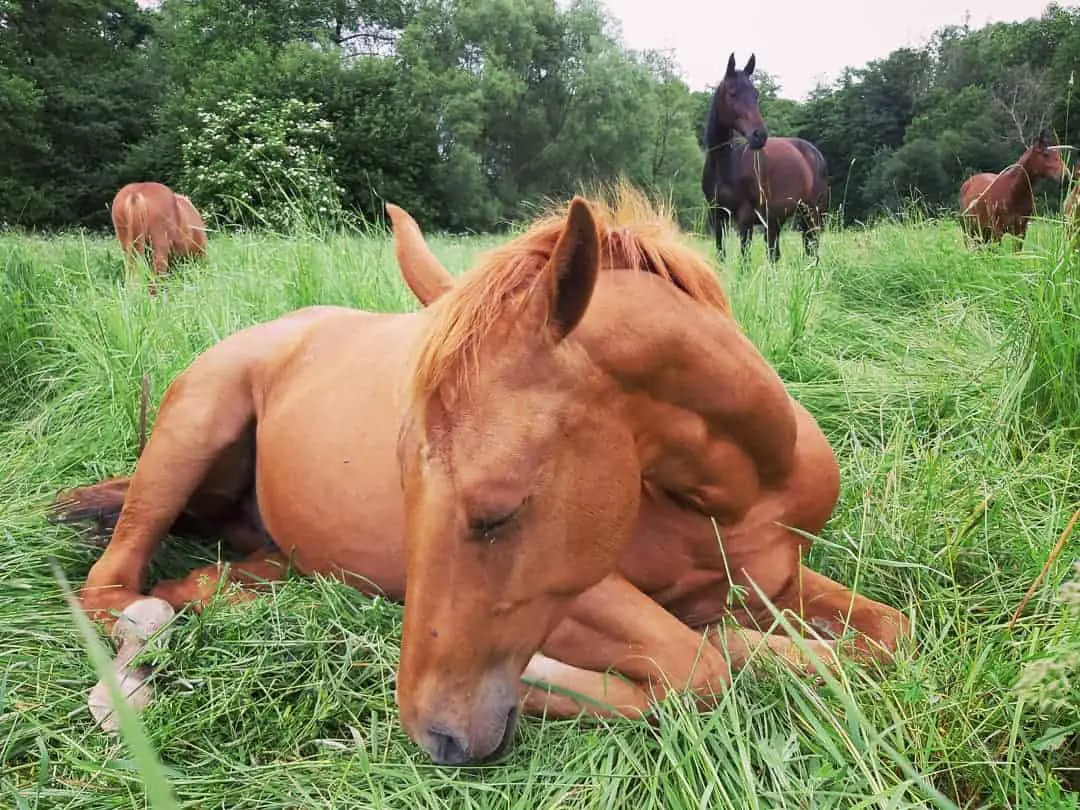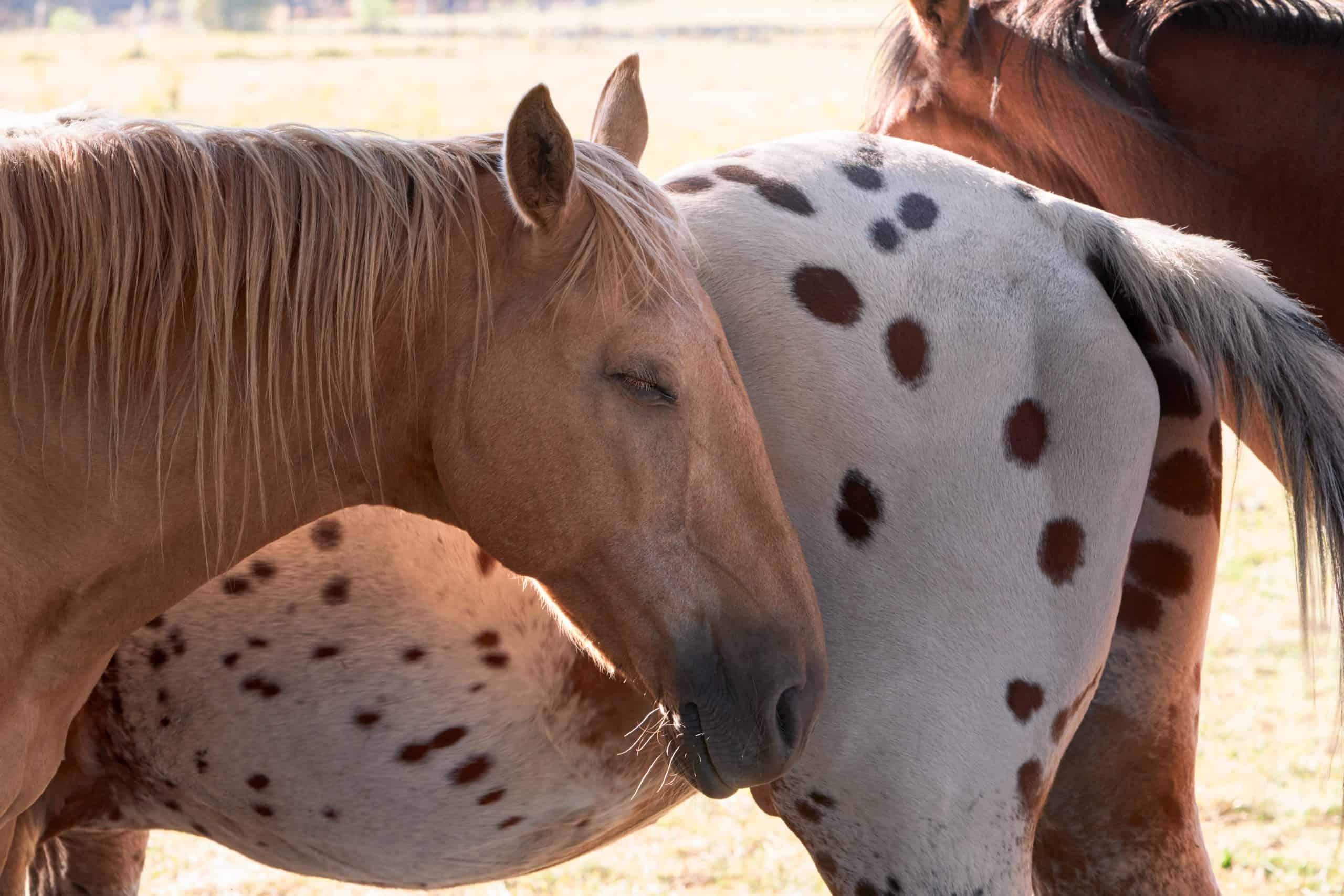Understanding the nuances of equine behavior is essential for horse owners and enthusiasts alike. One common question that arises is whether these majestic creatures lay down to rest. To answer this query, it’s important to delve into the fascinating world of horse sleep behavior.
- Horses have an amazing ability to sleep both standing up and lying down.
- Lying down is a normal part of horse sleep, especially for deep sleep stages.
- Horses only lay down to sleep when they feel safe and their environment allows it.
- Despite spending much time sleeping upright, horses do need to lay down to achieve full REM sleep.
- Foals and older horses may sleep longer, but typically horses sleep for about three hours a day.
Delving Deeper into Equine Rest Patterns

The complexity of equine rest patterns offers insights into the delicate balance between vigilance and the need for quality slumber in these animals. While observing horses in a resting posture is common, it is crucial to understand the specifics of their rest phases. The concept of ‘do horses lay down’ encompasses not just their position but also the intricacies underlying their sleep cycles. Equines experience various stages of rest, from light dozing to the more profound REM stage, where they are most susceptible and therefore require a secure environment to fully relax.
Variations in Equine Rest Episodes
Equine rest episodes are strategically structured to maximize survival while allowing essential rest. Their rest patterns differ significantly from human sleep habits, as horses engage in polyphasic sleep with multiple short rest periods. These patterns allow them to remain vigilant even while recharging. The timing and frequency of these episodes are shaped by environmental cues and herd dynamics, which add to the complexity of their rest habits.
- Short naps are common while standing and can vary in duration from a few minutes to around an hour.
- The necessary recumbent position for deeper sleep stages typically occurs in brief spurts, cumulatively amounting to less than an hour each day.
Clarifying Rest Versus Sleep in Equines
Identifying whether a horse is merely resting or genuinely sleeping is key to understanding their sleep behavior. A resting horse may stand quietly, but true sleep involves particular physiological changes, such as decreased heart rate and muscle relaxation, which are more evident when the horse is recumbent. Recognizing these signs enables caretakers to ascertain if a horse is obtaining sufficient restorative rest.
Environmental and Social Influences on Equine Rest
Equine rest is shaped by a myriad of factors, including their environment and social hierarchy. Domestication has modified natural sleep habits to some degree, with horses often adapting to the schedules and stable conditions set by humans. Key elements that influence equine rest include:
- Safety of the Surroundings: Horses show a preference for resting in locations where disturbances are minimal.
- Herd Dynamics: The pecking order within a herd can impact the amount and quality of rest, with higher-ranking horses sometimes resting less.
- Stable Comfort: A comfortable stable and suitable bedding can facilitate or hinder the preference to lie down for rest periods.
Comprehension of these facets of equine rest habits is essential for owners aiming to maintain their horse’s health and contentment. Ensuring that horses have the opportunity to lie down and engage in restorative sleep is vital for their welfare and affects aspects like temperament and performance. Acknowledging the interplay between their need for alertness and the vulnerability associated with deep rest stages is imperative for those responsible for equine care.
Insights on How Horses Sleep and Their Resting Needs

Exploring the complexities of how horses sleep, we uncover a versatile range of behaviors and physiological responses that are tailored to each horse’s unique requirements. These behaviors are shaped by an array of influences, reflecting the natural adaptability of equine rest. Our examination focuses on the diversity inherent in the resting habits of horses, highlighting their capacity to modify sleep behaviors in response to varying conditions.
Distinctive Sleep Requirements of Equines
Each horse’s sleep requirements are distinct, with factors such as age, activity level, and health playing a critical role. Younger horses, for instance, may recline for more extended periods to support their growth, while performance horses might need additional rest to recover from strenuous activities. The rest needs of horses also adapt to changes in their surroundings, including the care routines established by their human caretakers.
Adaptations for Alertness and Rest in Horses
Horses have developed remarkable physiological adaptations to balance their need for alertness with the necessity of rest. The stay apparatus allows them to rest while standing, conserving energy and remaining ready to flee from predators. Yet, to achieve comprehensive rest, they must also spend time in a prone position. This balance between standing dozing and lying down for deeper sleep is a testament to their evolutionary heritage.
Optimizing the Sleep Environment for Horses
The quality of rest for horses extends beyond individual physiology to encompass environmental and social factors. A serene and secure environment contributes to more regular and uninterrupted rest, whereas disruptive conditions can cause erratic sleep patterns. Elements such as the comfort of bedding, the availability of space for lying down, and the dynamics within a group of horses can significantly impact their rest quality.
By understanding the multifaceted aspects that influence horse sleep cycles and equine rest, caretakers can create conditions conducive to their horses’ relaxation and recovery. Attention to these details not only supports the horses’ overall well-being but also contributes to their optimal functioning and performance.
Insights into Resting Behaviors of Equines

Delving into the resting behaviors of horses reveals an array of postures that accommodate their survival instincts and preferences for comfort. These animals exhibit a dynamic range of sleeping habits that are essential to their well-being and health. For caregivers, recognizing the importance of various resting positions is integral to ensuring the optimal care of these animals.
Understanding Equine Light Sleep
Evolution has equipped horses with the ability to lightly doze in an upright position, a trait that has long been a source of interest for those studying equine behavior. This standing rest allows horses to remain alert to any potential dangers, even while they catch up on needed rest.
Evaluating the Efficiency of Equine Resting Mechanisms
The efficiency of the equine resting mechanism is evident in their unique physical adaptation. The stay apparatus is a fascinating anatomical feature that enables horses to rest without lying down. This complex system provides the following benefits:
- Locking mechanism: It allows the passive structures to bear the weight, reducing muscle fatigue.
- Energy efficiency: The apparatus aids in conserving energy while keeping the horse ready for action.
- Distributed weight: It ensures that no single limb is overburdened during rest.
Comprehending the Requirement for Recumbent Rest in Equines
While standing rest is suitable for short durations, horses also exhibit a natural tendency to recline for deeper, more restorative sleep, particularly at night. The recumbent state is indispensable for entering REM sleep, during which significant muscle relaxation and recovery occur.
Examining the Different Sleep Stages of Horses
The sleep stages in horses are characterized by the following:
- Light sleep: Quick, alert naps typically taken while standing.
- Slow-wave sleep: A deeper level of rest that can be achieved in various postures.
- REM sleep: This deepest sleep stage requires a prone position for complete relaxation.
Understanding the Importance of Lateral Rest for Equines
In the lateral resting position, horses lie fully on their sides, which is essential for achieving the muscle atonia characteristic of REM sleep. This state is crucial for their cognitive and physical health and is an integral component of their sleep cycle.
The Role of Sternal Recumbency in Equine Rest
Sternal recumbency is a semi-alert resting position where the horse lies with its legs folded under its body. This posture allows for a degree of relaxation while still enabling the horse to quickly stand if necessary, striking a balance between rest and readiness.
By appreciating the diversity in sleeping positions in horses, those responsible for their care can better cater to their needs. Recognizing the significance of both upright and recumbent rest helps ensure the welfare and comfort of these majestic creatures. Creating an environment that supports their instinctual sleeping behaviors is essential for their health and overall well-being.
Understanding Equine Nocturnal Habits

Horses exhibit sleeping behaviors that are crucial for their health and peak performance. Their polyphasic sleep patterns include distinct stages, tailored to their instinctual needs and the demands of their environment. These behaviors, critical for their well-being, allow horses to thrive both in competitive settings and in their daily routines.
Breaking Down the Phases of Equine Nocturnal Rest
To fully appreciate the complexity of equine rest, it’s essential to consider the various phases they undergo:
- Dozing: In this initial stage, horses remain semi-alert and can quickly become fully attentive if needed.
- Non-REM Sleep: This involves reduced brain activity, yet the horse retains some responsiveness.
Understanding the Significance of Equine Dreaming
The phase of REM sleep is integral to horses’ rest, marked by unique characteristics such as low muscle tone and the potential for dreaming. For horses to reach this crucial stage, they require a tranquil and secure setting, as it necessitates lying down. It’s during this phase that critical bodily restoration, including muscle repair and memory processing, takes place.
Internal and External Factors Influencing Equine Rest
Horses’ sleep-wake cycles are regulated by circadian rhythms, which are sensitive to environmental stimuli like natural light and ambient temperature. Here are some external factors that can influence these rhythms:
- Seasonal Shifts: Changes in daylight affect sleep cycles and behaviors.
- Stable Environment: Conditions within a stable, such as lighting and temperature, play a role in sleep regulation.
Life Stages and Sleep Requirements in Horses
The age of a horse significantly affects its rest needs. While young foals may require increased lying time to foster proper development, senior horses could face altered rest patterns due to physical changes or discomfort.
Assessing Equine Rest for Health Indicators
Monitoring the rest habits of horses can offer insights into their well-being. Any deviations from typical rest patterns may be symptomatic of health concerns or environmental stressors. Observing factors such as the overall duration of rest, the amount of time spent lying down, and any signs of unrest can help identify issues early on. Caregivers, by staying informed of a horse’s rest needs and providing an accommodating environment, can significantly enhance their charges’ quality of life and ability to perform.
Delving into Equine Sleep Dynamics and Well-being
Exploring the intricacies of how rest influences equine health is crucial for those caring for horses. Sleep quality, its various patterns, and the individual sleep needs of horses are all factors that contribute to their overall health. Properly addressing any disturbances in these areas is key to sustaining their well-being and achieving peak performance in their respective disciplines.
Identifying and Tackling Sleep Disturbances in Horses
It is important for caregivers to recognize the symptoms of sleep disturbances, which can significantly impact a horse’s health:
- Afflictions like narcolepsy, though uncommon, can pose serious risks for horses.
- Respiratory disruptions during sleep may lead to diminished rest quality and subsequent health problems.
- Factors such as environmental stress or physical discomfort may impede a horse’s ability to sleep well, influencing their daily functioning.
Early detection and intervention are essential to prevent long-term issues and promote a horse’s health and well-being.
The Crucial Role of Restorative Sleep for Horses
Sleep is vital for a horse’s mental and physical health, impacting:
- Behavioral disposition: A well-rested horse is generally more even-tempered and manageable.
- Defense mechanisms: Sufficient sleep is integral to maintaining a strong immune defense.
- Recovery processes: Essential for muscle and tissue recovery, especially after physical exertion.
Therefore, ensuring that horses have adequate rest is synonymous with ensuring their health and longevity.
Assessing Sleep for Early Detection of Health Issues
Regular observation of a horse’s sleep can reveal much about their overall health. Changes in their typical rest patterns may be indicative of health concerns that need to be addressed. Recognizing these changes is an important step in providing the necessary care for horses.
Strategies for Managing Sleep Challenges
Combating sleep disorders in horses requires a comprehensive approach that might include:
- Creating a peaceful stable environment with appropriate bedding and minimal disturbances.
- Seeking veterinary solutions for any physical conditions affecting rest.
- Implementing training and routines to alleviate stress and promote relaxation.
Establishing an environment that encourages natural resting behaviors is crucial for the prevention and management of sleep-related issues.
Optimizing Rest for the Competitive Horse
For performance horses, the link between rest and competitive success is strong. Enhancing sleep quality through tailored strategies can lead to better performance:
- Regulated exercise: A well-planned exercise regime can help horses rest more efficiently.
- Diet: Proper nutrition is essential for overall health and can positively affect rest.
- Post-event care: Proper cool-down routines and relaxation techniques can help horses wind down and sleep better.
Adjusting these strategies to suit each horse’s needs can significantly improve their rest and overall performance.
Consequences of Suboptimal Rest in Horses
Lack of proper rest can result in a range of negative effects for horses:
- Decline in cognitive function, which may complicate training efforts.
- Decreased resilience, raising the risk of injury.
- Alterations in behavior, potentially impacting their interactions and overall mood.
Proactively addressing factors that contribute to inadequate rest is vital for preventing these issues.
In conclusion, horse sleep behavior is a key indicator of their health status. Caregivers play an essential role in ensuring that horses maintain regular sleep patterns by providing an environment and care routine conducive to natural sleep behaviors. This not only improves the horses’ quality of life but also their functionality, whether in competitive arenas or as valued companions.
Curious about the behaviors and care of horses during different seasons? While exploring the topic of whether horses lay down to sleep, it’s also interesting to delve into other aspects of their lives. For instance, you might wonder how horses stay warm in the winter or when they shed their winter coat. Additionally, it’s crucial for horse owners to know how long a horse can lay down before it’s in danger. These insights can help you understand and care for these magnificent creatures better.
Practical Insights for Horse Owners
How to Ensure Your Horse Gets Enough Sleep
Creating a safe and comfortable environment is key to ensuring horses get enough rest. Factors such as bedding, shelter, and herd dynamics can influence sleep quality.
Identifying Sleep Deprivation in Horses
Horse owners should be aware of the signs of sleep deprivation, which can include changes in behavior, performance, and physical appearance.
To gain a deeper understanding of horse sleep behavior, a trusted source is the Horse & Hound article “Do horses sleep standing up? Or do they prefer to lie down…” which explores the intricacies of how equine rest impacts their overall well-being.



